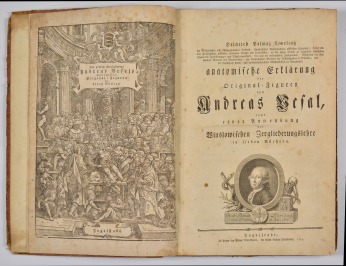Andreas Vesalius (1514-1564) De Humani Corporis Fabrica. 1555 VESALIUS, Andreas (1514-1564). De Humani Corporis Fabrica Libri Septem. Basel: Johannes Oporinus, August 1555. Second folio edition, establishing the corrected and revised authorial text, a publication 'even more lavish than the first' (Heirs of Hippocrates). It was printed on heavier paper with larger type, a new set of woodcut initials was cut, and the famous frontispiece depicting an anatomy was recut, now with a clothed (previously naked) figure perching on the left; the highly influential, elegant and scientific anatomical illustrations and portrait of Vesalius are printed from the original blocks. This copy has fine medical provenance, being from the library of Johann Hermann (1738-1800), the important French physician whose zoological collections formed the basis of the Natural History Museum of Strasbourg, and later belonging to Rudolf Virchow (1821-1902), the German physician regarded as the father of modern pathology. The Fabrica is 'a complete anatomical and physiological study of every part of the human body... [dealing] with bones and muscles, blood vessels, nerves, abdominal viscera, thoracic organs and the brain' (PMM). It is considered not only the most famous anatomical book ever published but the most beautiful, combining scientific exposition, art and typography to create a Renaissance masterpiece. Garrison-Morton, 377; Horblit 98 (1543 edition); Dibner 122; PMM 71; Choulant pp. 181ff; Heirs of Hippocrates 283. Folio (408 x 260mm). Woodcut dedicatory frontispiece showing Vesalius lecturing from the dissection table, portrait of Vesalius, about 200 woodcut text illustrations, 23 full-page, two folding, last leaf with printer's device on verso, historiated initials. Second folding plate bound between 2a5-6 (title with some creasing and small chip in blank lower fore-corner, short repaired tears in lower margins of s6 and t1, a few leaves lightly stained and finger-soiled). 18th-century marbled half calf over speckled paper boards, spine lettered in gilt (somewhat rubbed with loss of leather to foot of spine and one corner, minor worming in corner of upper board and endpaper). Provenance: several leaves annotated at an early date, some extensively – other inscriptions to lower margin of title and front endpaper – ‘Bibliothecae Hermannianae Argentorati’, i.e. Johann Hermann (French physician and naturalist, 1738-1800; inscription, with gift inscription to:) – Karl Sulzer (medical writer) – Rudolf Virchow (German physician and pathologist, 1821-1902; bookplate) – ‘Virchow possedis, 1902-1940’ (probably Hans Virchow, anatomist and son of Rudolf, 1852-1940; inscription) – ‘H. Stieve…1940’ (probably Hermann Stieve, German professor of anatomy, 1886-1952; inscription).
Andreas Vesalius (1514-1564) De Humani Corporis Fabrica. 1555 VESALIUS, Andreas (1514-1564). De Humani Corporis Fabrica Libri Septem. Basel: Johannes Oporinus, August 1555. Second folio edition, establishing the corrected and revised authorial text, a publication 'even more lavish than the first' (Heirs of Hippocrates). It was printed on heavier paper with larger type, a new set of woodcut initials was cut, and the famous frontispiece depicting an anatomy was recut, now with a clothed (previously naked) figure perching on the left; the highly influential, elegant and scientific anatomical illustrations and portrait of Vesalius are printed from the original blocks. This copy has fine medical provenance, being from the library of Johann Hermann (1738-1800), the important French physician whose zoological collections formed the basis of the Natural History Museum of Strasbourg, and later belonging to Rudolf Virchow (1821-1902), the German physician regarded as the father of modern pathology. The Fabrica is 'a complete anatomical and physiological study of every part of the human body... [dealing] with bones and muscles, blood vessels, nerves, abdominal viscera, thoracic organs and the brain' (PMM). It is considered not only the most famous anatomical book ever published but the most beautiful, combining scientific exposition, art and typography to create a Renaissance masterpiece. Garrison-Morton, 377; Horblit 98 (1543 edition); Dibner 122; PMM 71; Choulant pp. 181ff; Heirs of Hippocrates 283. Folio (408 x 260mm). Woodcut dedicatory frontispiece showing Vesalius lecturing from the dissection table, portrait of Vesalius, about 200 woodcut text illustrations, 23 full-page, two folding, last leaf with printer's device on verso, historiated initials. Second folding plate bound between 2a5-6 (title with some creasing and small chip in blank lower fore-corner, short repaired tears in lower margins of s6 and t1, a few leaves lightly stained and finger-soiled). 18th-century marbled half calf over speckled paper boards, spine lettered in gilt (somewhat rubbed with loss of leather to foot of spine and one corner, minor worming in corner of upper board and endpaper). Provenance: several leaves annotated at an early date, some extensively – other inscriptions to lower margin of title and front endpaper – ‘Bibliothecae Hermannianae Argentorati’, i.e. Johann Hermann (French physician and naturalist, 1738-1800; inscription, with gift inscription to:) – Karl Sulzer (medical writer) – Rudolf Virchow (German physician and pathologist, 1821-1902; bookplate) – ‘Virchow possedis, 1902-1940’ (probably Hans Virchow, anatomist and son of Rudolf, 1852-1940; inscription) – ‘H. Stieve…1940’ (probably Hermann Stieve, German professor of anatomy, 1886-1952; inscription).

.jpg)





.jpg)
.jpg)




.jpg)

Testen Sie LotSearch und seine Premium-Features 7 Tage - ohne Kosten!
Lassen Sie sich automatisch über neue Objekte in kommenden Auktionen benachrichtigen.
Suchauftrag anlegen